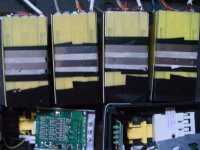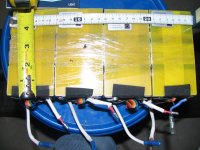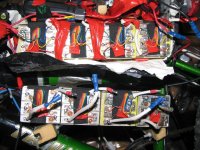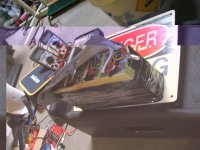mikereidis
1 kW
- Joined
- Jul 24, 2008
- Messages
- 343
I didn't get around to riding last night; just watched my bad cell voltage as the pack charged slower (and safer!) than it normally does. Now I realize that with the bad batts at 21.00v, the bad cells were higher than 4.20v, and thus the bad cells just get worse as time goes by.
A smattering of ideas gelled, and the harsh light of morning hasn't diminished my enthusiasm, so here goes:
DMS or "Danger Management System". System is modular. Pick and choose your danger profile and options:
BTW, I'd want a system that could be configured to any reasonable voltage or current. So, you could use this with individual cells or complete batteries.
Over-current protection: I think a fuse and/or circuit breaker are sufficient, to protect against shorts or controller failure. Most controllers have current limit. CA can provide limit. For those who need something better, a solid state, fast acting, over-current module could be built or bought needing just 3 wires I think. This is for charge AND discharge. It's possible you might want a lower limit for charge, but charger also has its' limits too. I shudder to think what a bridge rectifier failure could do though, and that's one reason I have a 40a (or 30?) rectifier unit, with heat sink.
Under-voltage protection: I think a voltmeter and a reasonably conscientious rider keeping an eye on voltage, especially up hills or under acceleration, is a reasonable way to do LVC. A nice upgrade could be a voltage monitor that beeps under specified voltages, perhaps changing sound as voltage decreases further into the danger zone. Another upgrade would cut power completely or partially (reduce current limit) when LVC.
LVC could be done by monitoring a single cell voltage (the worst cell) pretty well IMO. Or could be done monitoring the whole pack voltage or the single battery with lowest voltage. More sophisticated, a switching system could be used to slowly, progressively monitor all cells and figure out which is the lowest and should be watched most closely.
Over-voltage/charge protection: YW batts refuse to power more than a few milli-amps when charged over about 21.10 volts. This is annoying since those are the batts I WANT to discharge to safer levels. Probably protects the YW equipment some. (BTW, saw all 5 pieces of YW LiMn equipment in Bells Corners yesterday; still no batts or chargers.) I'm not seeing a GREAT need to implement over-voltage protection to protect controller, but might be a need to consider. DMM and brain work OK for that.
Charging: This is a biggie, and I think I may have an interesting solution. "Sacrificial cell" monitoring. (Search for sacrificial here and I think you'll get some hits.) I was getting rather bored charging last night; all I had to do was keep my highest voltage while charging bulged cell at 4.20v, and the 16 good cells slowly rose safely from 3.8v to 4.07v, and in unison (no balancing needed). No BMSs were tripping on me, and no ungodly voltages seen. So it seems to me this technique will generally work, so long as you know and can monitor the voltage of the worst cell.
For discharge this sacrificial cell can be used, OR it could be tapped around and used for bike accessories or whatever. (Note that bad cells always seem to be at ends of batts.) Only issue if you don't use for motor power is that before recharging, you'd want voltage on this cell to be as low as all the other cells in pack. If you're unlucky enough that all your cells match exactly, a sacrificial cell could be emulated with a 1-20 milli-ohm resistance in series with that cell.
So I think that safe charging can be done with a single cell (or batt) voltage monitor "module", set to trip at user specified voltage from 1-100v or whatever. If you want more (perhaps you expect that some other cells might get worse and you might not notice and move the voltage monitor connections), multiple modules could be added. 4 bad cells might benefit from 4 monitor modules. Or go full bore and monitor every cell if you must, but I think 1 cell is enough. Regardless, I personally want to be able to check any cell voltage (and charge/discharge current and total voltage of system) at any time in an automated manner, perhaps via USB peripheral.
Cell/batt balancing don't really seem to be a major issue with these batts. Balancing could be done manually, semi-manually, or fully automatically, using just one shunt type circuit on worst cell/batt, or on all bulged cells/batts. But good cells seem to stay nicely balanced all by themselves.
Fast charging could start with a low resistance load, like a 1500w heater plugged into primary outlet, for more or less CC mode. When voltage limit is reached on sacrificial cell(s)/batt(s), primary load is switched off and secondary load, connected through a Triac based light dimmer type circuit (or modified standard 5amp dimmer?) is brought into play. Primary and secondary loads can be anything that works, heaters, lights (although high inrush currents are an issue with light bulbs that dimmers, or a thermistor or something may compensate for) or small stove for the alcohol still.
Triac based light dimmer type circuit would be controlled by voltage measurement(s) of cell(s). Note that, IMO so far, "AC dimming" works well for voltage and current control. The batts/cells seem to average out the 120 HZ modified sinewave peaks, so the dimmer/PWM method of control works OK (Even if peak currents every 120th of a second are higher than average or RMS current).
I have a UPM Kill-A-Watt type meter I use on charger now. Divide watt-hours by 120 to get amp-hours. I think I could set KWH price to get direct amp-hour reading. I DO think my DC and AC current measurements are higher than real RMS though, due to the modified/clipped sine wave. Once I read 16amps DC on charging and around 18-19 amps AC and my 15amp breaker; which is probably less now due to multiple inductive trips, did not trip.
For further danger management, an isolation transformer could be added, but that's a pretty boring expenditure.
I think that covers the bases of danger management. With the right options I think it might actually be fittable into a large 25 pack of king-size, especially if we exclude the size of input and output 120vac inlets/outlets, or use miniature ones.
Disclaimer: "All Danger brand products are sold with no warranty, express or implied. They are intended only for experimental usage by competent professionals with the requisite skills to handle such equipment in safe, controlled laboratory conditions. Do not inhale."
A smattering of ideas gelled, and the harsh light of morning hasn't diminished my enthusiasm, so here goes:
DMS or "Danger Management System". System is modular. Pick and choose your danger profile and options:
BTW, I'd want a system that could be configured to any reasonable voltage or current. So, you could use this with individual cells or complete batteries.
Over-current protection: I think a fuse and/or circuit breaker are sufficient, to protect against shorts or controller failure. Most controllers have current limit. CA can provide limit. For those who need something better, a solid state, fast acting, over-current module could be built or bought needing just 3 wires I think. This is for charge AND discharge. It's possible you might want a lower limit for charge, but charger also has its' limits too. I shudder to think what a bridge rectifier failure could do though, and that's one reason I have a 40a (or 30?) rectifier unit, with heat sink.
Under-voltage protection: I think a voltmeter and a reasonably conscientious rider keeping an eye on voltage, especially up hills or under acceleration, is a reasonable way to do LVC. A nice upgrade could be a voltage monitor that beeps under specified voltages, perhaps changing sound as voltage decreases further into the danger zone. Another upgrade would cut power completely or partially (reduce current limit) when LVC.
LVC could be done by monitoring a single cell voltage (the worst cell) pretty well IMO. Or could be done monitoring the whole pack voltage or the single battery with lowest voltage. More sophisticated, a switching system could be used to slowly, progressively monitor all cells and figure out which is the lowest and should be watched most closely.
Over-voltage/charge protection: YW batts refuse to power more than a few milli-amps when charged over about 21.10 volts. This is annoying since those are the batts I WANT to discharge to safer levels. Probably protects the YW equipment some. (BTW, saw all 5 pieces of YW LiMn equipment in Bells Corners yesterday; still no batts or chargers.) I'm not seeing a GREAT need to implement over-voltage protection to protect controller, but might be a need to consider. DMM and brain work OK for that.
Charging: This is a biggie, and I think I may have an interesting solution. "Sacrificial cell" monitoring. (Search for sacrificial here and I think you'll get some hits.) I was getting rather bored charging last night; all I had to do was keep my highest voltage while charging bulged cell at 4.20v, and the 16 good cells slowly rose safely from 3.8v to 4.07v, and in unison (no balancing needed). No BMSs were tripping on me, and no ungodly voltages seen. So it seems to me this technique will generally work, so long as you know and can monitor the voltage of the worst cell.
For discharge this sacrificial cell can be used, OR it could be tapped around and used for bike accessories or whatever. (Note that bad cells always seem to be at ends of batts.) Only issue if you don't use for motor power is that before recharging, you'd want voltage on this cell to be as low as all the other cells in pack. If you're unlucky enough that all your cells match exactly, a sacrificial cell could be emulated with a 1-20 milli-ohm resistance in series with that cell.
So I think that safe charging can be done with a single cell (or batt) voltage monitor "module", set to trip at user specified voltage from 1-100v or whatever. If you want more (perhaps you expect that some other cells might get worse and you might not notice and move the voltage monitor connections), multiple modules could be added. 4 bad cells might benefit from 4 monitor modules. Or go full bore and monitor every cell if you must, but I think 1 cell is enough. Regardless, I personally want to be able to check any cell voltage (and charge/discharge current and total voltage of system) at any time in an automated manner, perhaps via USB peripheral.
Cell/batt balancing don't really seem to be a major issue with these batts. Balancing could be done manually, semi-manually, or fully automatically, using just one shunt type circuit on worst cell/batt, or on all bulged cells/batts. But good cells seem to stay nicely balanced all by themselves.
Fast charging could start with a low resistance load, like a 1500w heater plugged into primary outlet, for more or less CC mode. When voltage limit is reached on sacrificial cell(s)/batt(s), primary load is switched off and secondary load, connected through a Triac based light dimmer type circuit (or modified standard 5amp dimmer?) is brought into play. Primary and secondary loads can be anything that works, heaters, lights (although high inrush currents are an issue with light bulbs that dimmers, or a thermistor or something may compensate for) or small stove for the alcohol still.
Triac based light dimmer type circuit would be controlled by voltage measurement(s) of cell(s). Note that, IMO so far, "AC dimming" works well for voltage and current control. The batts/cells seem to average out the 120 HZ modified sinewave peaks, so the dimmer/PWM method of control works OK (Even if peak currents every 120th of a second are higher than average or RMS current).
I have a UPM Kill-A-Watt type meter I use on charger now. Divide watt-hours by 120 to get amp-hours. I think I could set KWH price to get direct amp-hour reading. I DO think my DC and AC current measurements are higher than real RMS though, due to the modified/clipped sine wave. Once I read 16amps DC on charging and around 18-19 amps AC and my 15amp breaker; which is probably less now due to multiple inductive trips, did not trip.
For further danger management, an isolation transformer could be added, but that's a pretty boring expenditure.
I think that covers the bases of danger management. With the right options I think it might actually be fittable into a large 25 pack of king-size, especially if we exclude the size of input and output 120vac inlets/outlets, or use miniature ones.
Disclaimer: "All Danger brand products are sold with no warranty, express or implied. They are intended only for experimental usage by competent professionals with the requisite skills to handle such equipment in safe, controlled laboratory conditions. Do not inhale."








